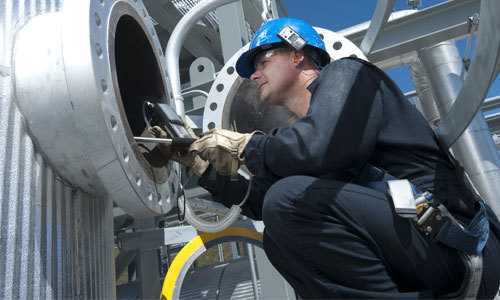

|
Edward Lowton
Editor |


|
| Home> | Health, Safety & Welfare | >Gas detection | >Safety in confined spaces |
Safety in confined spaces
15 June 2019
Confined spaces can be dangerous – low oxygen levels, combustible gases, and toxic substances are some of the threats. At Safety & Health Expo 2019, Industrial Scientific will showcase products to help boost safety in such areas.

Before entering a confined space, you need to understand the regulations, obtain permits, gear up, and test the atmosphere within the space. Even after the space has been checked and certified as safe, you must monitor the air continuously while workers are inside. Training classes can help you understand the proper procedures for sampling in a confined space.
Gas monitoring considerations include:
Pre-entry air sampling
A gas detector with a pump allows you to draw air samples from the space during initial testing. The Ventis Pro, Ventis MX4, and MX6 iBridhave pump options which allow users to take samples of a space before entering. Sampling accessories like probes and tubing kits make it easier for workers to draw accurate samples from a space. The Radius BZ1 also has a pump option, which provides continuous monitoring from outside of the space while the entrant is inside.
Wireless monitoring
Wireless gas detectors like Ventis Pro provide you and your team with ongoing real-time data. With LENS Wireless, the attendant or 'hole watch' can see what is happening inside the confined space and respond quickly if conditions worsen inside the space. Using these monitors with an RGX Gateway lets supervisors at a control centre continuously monitor each entry in real-time without the need for an attendant to be stationed at each entry point.
Intrinsic safety
Any equipment that will occupy the confined space should be intrinsically safe to avoid explosion hazards. This includes not only gas detectors, but also any other support equipment such as lighting, cables, and ventilators.
Maintenance and compliance
The DSX Docking Station provides automated calibration, bump testing, record keeping, and instrument diagnostics.
Battery life
Extended battery life lets you keep working longer without needing to take safety equipment out of the field for a battery swap. Ventis Pro gas detectors offer three different battery options to fit your run time needs. The Radius BZ1 can run continuously for seven days on battery power and can run indefinitely with an extended run time power supply.
Ease of operation
User-friendly equipment simplifies operation and promotes faster response time during an emergency. Ventis Pro Multi-Gas Monitors and Radius BZ1 Area Monitors convey audible alarms and clear messages such as ‘EVACUATE’ to help clarify emergency situations and facilitate proper action.
Digital permit to work
To keep workers safe in permit to work required confined spaces, it is imperative that the permit to work is filled out completely and correctly, including both initial gas readings necessary for entry and readings from continuous monitoring. SmartWork digital permits help to ensure workers in confined spaces can work safely and without unnecessary permit approval delays. Through integration with the Ventis Pro gas monitor, gas readings are automatically submitted to the confined space permit to work so there is never a doubt whether the readings were actually taken. Stand 3654
- Hazardous gas protection
- Smart gas detection system
- Work smarter and safer with LENS Wireless
- Carbon dioxide sensor
- Multi-gas monitor
- New gateway joins wireless gas detection portfolio
- New wi-fi battery introduced for multigas monitor
- Area monitors for turnarounds
- Gas detector service
- No gas detectors

















